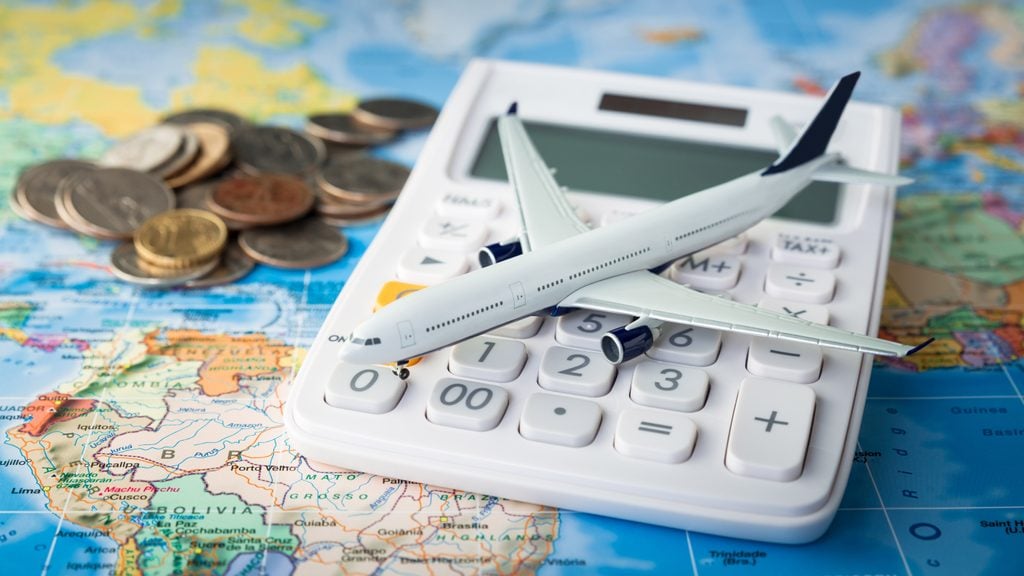How Much Would It Actually Cost to Travel Around the World?
Updated: Jun. 28, 2023

With a bit of budgeting and planning, you can make your trip around the world a reality.
Traveling around the world is a dream held by many, but there are a lot of variables to consider when planning a trip around the world. Creating an itinerary that best suits your needs is crucial, and it’s important to keep in mind that each world trip is supposed to be different. For starters, how long do you spend in one place and how do you beat the crowds at the most popular tourist attractions? And, most importantly, how much does it cost to make your travel dreams a reality? As you’re planning, here are 18 one-of-a-kind adventures to add to your bucket list.
How to budget for your trip
One of the most important parts of planning a trip around the world is creating a budget and sticking to it. But how much should you set aside for your trip? “We’ve tracked the budget and interviewed thousands of travelers about world trips and the answer varies,” says Konrad Waliszewski, founder and CEO of travel app TripScout. “On the low-end, we’ve seen people successfully do it as low as $50 a day (including all costs: flights, lodging, food, activities, etc.). This is obviously a much more backpacker and hostel lifestyle. For people doing it more reasonably and comfortably, the average is $2,500 a month in lower-cost countries (e.g., Southeast Asia), $3,500 a month in medium-cost countries (e.g., Eastern Europe), and $5,000 a month in expensive cities (e.g., Paris).” Notifying banks of travel plans, charging electronic devices, and smartly packing carry-on bags are just a few things smart travelers always do before their flights.
Spending thousands of dollars on a once-in-a-lifetime experience is a lot of money to spend, but some perspective is needed. “While this sounds like a lot to many people, these travelers often no longer pay their rent or mortgage as they cancel their lease or rent out their place before embarking on their travel destination,” explains Waliszewski. “They also no longer have big expenses like car payments, car insurance, expensive grocery bills from Whole Foods, etc. If you’re able to work remotely, then it’s often even cheaper working while traveling the world than living in a major city.”
After figuring out how much you want to spend on your trip, the next thing to work out is where you want to go and how you’re going to get there. There are positives and negatives to booking all of your flights in advance. Buying a Round the World (RTW) ticket in advance helps you plan out your trip, but removes some of the spontaneity in deciding to book as you go.
“For budget travelers, traveling around the world is doable if you’re strategic about when you book your flight as well as flexible on the times that you’d like to travel,” says Juliano Lopez, Head of Research & Insights at Skyscanner. “The introduction of transatlantic flights on low-cost carriers has undoubtedly altered the landscape for cheap international flight deals. Except for in peak summer season, it’s relatively easy to find cheap flights from U.S. cities to European hubs like London, Paris, Stockholm, and Amsterdam, even on full-service airlines.” Where you go and what you do is up to you, but keep in mind that some days are better than others when booking flights.
The Budget Traveler: $20,000 to $30,000
According to AirTreks, a trip planning service that’s a leader in multi-stop international travel, budget travelers who embark on trips around the word cost on average between $20,000 and $30,000. Having less money to work with doesn’t mean that your trip won’t be life-changing. If anything, following a stricter budget allows you to be creative with your options and be more mindful of your spending. There are a lot of budget-friendly options when booking accommodation, like staying with friends and family, booking a room in hostels, or even spending part of your time camping in U.S. national parks.
It’s good to keep in mind that having less money to spend on accommodation doesn’t mean you have to share a room with strangers or have it be any less luxurious than other trips. For example, what you see in the movies can actually happen in reality. “HomeExchange (widely known from Nancy Meyers’ movie The Holiday) is $150/year, which gives members access to unlimited exchanges, either simultaneous or non-simultaneous. With over 400,000 homes in 187 countries, it is entirely possible to travel around the world with our membership,” Marina Goodwin, U.S. public relations manager for HomeExchange, tells Reader’s Digest. “Many of our members use our platform to travel across the globe, and it not only saves money but provides access to unique, authentic homes off the beaten path. Saving on accommodation (without sacrificing quality) allows travelers to spend more on experiences, entertainment, food, or transportation.”
Traveling is even cheaper if you’re under a certain age or a student because of student discounts. For example, youths under the age of 27 get 25 percent off adult prices for rail travel in Europe if they book through Eurail. When planning your trip, make sure you know these 15 less crowded alternatives to the most popular tourist attractions.
The Jet-Setting World Wanderer: $30,000 to $50,000
While traveling on a budget is a wise choice, sometimes splurging on new restaurants, mixing in hotel rooms, and booking unique experiences and private tours might be what you’re after. “I would recommend that most people budget more like $30,000 – $35,000 for a memorable, safe, and extensive trip that takes them to most places they want to go,” Kate Sullivan, Head of Experience at Secret Fares, tells Reader’s Digest. Sullivan recommends planning routes in the off-season, trying non-standard lodging options like reaching out to your network, and enlisting the service of a booking agency to help plan everything out.
Susie Chau is a sabbatical coach and travel advisor who helps high-achieving professionals take a sabbatical from work to travel. “I took a yearlong trip around the world with my husband from August 2013 to August 2014 (when U.S. currency exchange rates were significantly higher than now) and visited all seven continents, 23 countries, and 22 U.S. states,” Chau says. “Our total costs came out to approximately $45K based on these factors.” These are the 13 secrets veteran globetrotters wish you knew.
The Luxurious Vacationer: $50,000+
If the name of the game is luxury, then anything within reason is possible. “If you’re looking to travel in total luxury, the sky is the limit—$5,000+ first-class plane tickets, $1,000-night hotel rooms, and the best restaurants all add up quickly,” says Sullivan. Here are 15 of the most luxurious train rides in the world.
If you’re looking to pay a lot of money for the ease of travel, then going on a cruise might be for you. “I’d recommend having a look at something like back to back segments with Regent Seven Seas Cruises. For example, they have what was coined ‘the most luxurious ship at sea’ in the Regent Explorer departing from Barcelona this November for 76 nights, dotting the globe toward New Zealand,” Shylar Bredewold, owner of Odyssean Travel, tells Reader’s Digest. Bredewold says that experience starts around $47,000 per person and includes up to 200+ shore excursions. However, to fully circumnavigate around the globe you would need a second segment.
“Air cruise is also a thing, there are options from the likes of Four Seasons or Crystal Air Cruise—many of which can be custom-built at the higher end of the price spectrum,” says Bredewold. “The journey won’t be such a long time away from home, but the rate might reflect the rapidity with which travelers cross the globe. Expect something more like $60,000-$150,000 per person for 30-90 days, but not quite as many calls to port as the traditional ocean-faring cruise.”
If you’re looking for a longer option for a cruise that would last closer to a year, Viking Cruises has an “Ultimate World Crusie” option which goes around the world for the price of $92,990. This specific cruise option begins and ends the 245-day journey in London, England and visits six continents and 111 cities and ports. Here are 28 secrets cruise lines won’t tell you.
Always be prepared
There are other factors that come into consideration on your year-long adventure, including finding the perfect travel insurance for you and making sure your passport and relevant documentation is up-to-date. If you’re going to a country that requires a visa, it’s imperative to allow ample time for the application process. Whatever you do, never overstay longer past the time allotted for your visa. For example, a few consequences of overstaying in the Schengen Zone in Europe include deportation, heavy fines, and bans. It’s best to double and triple check your documents and the rules and regulations of each city and country your visiting. However, it’s important to note that after your travels around the world, it may be hard coming back to the comforts of home.
Keep track of your spending habits when you’re on the road. Buying new credit cards for the signup bonus and using those cards for frequent flyer miles may seem great as a way to save money in the beginning, but it might be best to keep a careful eye on those numbers as time goes on. “You’ll also want to make sure that you can afford to hit the minimum spend while still paying your balances in full each month to avoid paying interest charges,” says Greg Mahnken, a credit industry analyst at Credit Card Insider. “Paying interest on credit cards can quickly sap the value out of any rewards you earned.”
As with anything in life, there are many things that are far out of your control. It’s best to have all of your flights, accommodation, and contact information safe and in a secure place. To protect yourself against hackers, make sure you have a VPN, only use secure apps, and double-check that two-step verification is installed, whenever possible. Safety tips, like learning emergency phrases in the local language and telling a loved one where you’re going, apply to everyone including solo travelers who wander the world alone.
In the end, enjoy the adventure
For many people, traveling around the world is an incredible, once-in-a-lifetime experience. As long as you make the appropriate preparations and take the necessary precautions, everything should fall into place. And even if everything falls apart instead of falling into place? That’s part of the experience.
